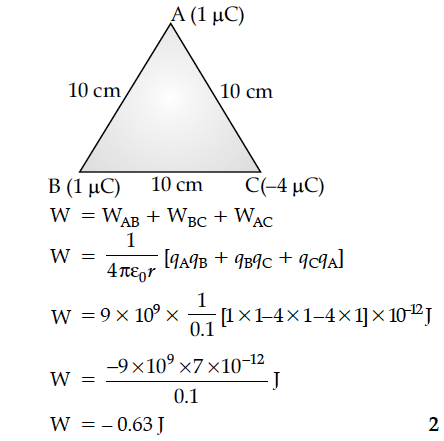Calculate the amount of work done to dissociate a system of three charges 1 mC, 1 mC and – 4 mC placed on the vertices of an equilateral triangle of side 10 cm.


What is the amount of work done in moving a point charge around a circular arc of radius r at the center where another point charge is located ?
Why must electrostatic field at the surface of a charged conductor be normal to the surface at every point ? Give reason.
The amount of work required to increase the distance between -6µC and 4µC from 6 cm to 18 cm will be :
(a) 1.8 J
(b) 2.4 J
(c) 1.8 µJ
(d) 2.4 µJ
The electric potential due to point charge 3 nC at distance of 9 cm is
(a) 270 v
(b) 3 v
(c) 300 v
(d) 30 v
Obtain the expression for the potential due to an electric dipole of dipole moment p at a point ‘d’ on the axial line.
Choose the SI unit of electric potential energy :
(a) Joule
(b) Coulomb
(c) Newton per coulomb
(d) Erg
Five charges, q each are placed at the corners of a regular pentagon of side a.
(i) What will be the electric field at O if the charge from one of the corners (say A) is removed ?
(ii) What will be the electric field at O if the charge q at A is replaced by - q ?
An electric dipole is held in a uniform electric field.
(i) Show that the net force acting on it is zero.
(ii) The dipole is aligned parallel to the field. Find the work done in rotating it through the angle of 180°.
Write two properties of equipotential surfaces. Depict equipotential surfaces due to an isolated point charge. Why do the equipotential surfaces get closer as the distance between the equipotential surfaces and the source charge decreases ?
The figure shows two sinusoidal curves representing oscillating supply voltage and current in an ac circuit.
Two point charges q1 and q2 are located at and respectively in an external electric field E. Obtain the expression for the total work done in assembling this configuration.
Draw a plot showing the variation of (i) electric field (E) and (ii) electric potential (V) with distance r due to a point charge Q.
A 9 V battery is connected in series with a resistor. The terminal voltage is found to be 8 V. Current through the circuit is measured as 5 A. What is the internal resistance of the battery?
